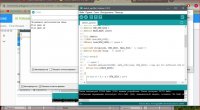Как то так
C++:
#define REPLACE_FASTLED // пункт 0
#define COLOR_DEBTH 1 // пункт 1
#include "microLED.h" // пункт 3
//#include <FastLED.h>
#include <SPI.h>
#include <SD.h>
#define NUM_LEDS 289
#define DATA_PIN 6
#define CHIPSET WS2811
#define CMD_NEW_DATA 1
#define BAUD_RATE 115200
File fxdata;
//CRGB leds[NUM_LEDS];
LEDdata leds[NUM_LEDS];// пункт 4
microLED strip(leds, NUM_LEDS, DATA_PIN); // пункт 5
#define FastLED strip // пункт 6
void setup()
{
// пункт 7
// FastLED.addLeds<CHIPSET, DATA_PIN>(leds, NUM_LEDS); //see doc for different LED strips
Serial.begin(BAUD_RATE);
for(int y = 0 ; y < NUM_LEDS ; y++)
{
leds[y] = BLACK; // set all leds to black during setup
}
FastLED.show();
pinMode(10, OUTPUT); // CS/SS pin as output for SD library to work.
digitalWrite(10, HIGH); // workaround for sdcard failed error...
if (!SD.begin(4))
{
Serial.println("sdcard initialization failed!");
return;
}
Serial.println("sdcard initialization done.");
// test file open
fxdata = SD.open("myanim.dat"); // read only
if (fxdata)
{
Serial.println("file open ok");
fxdata.close();
}
}
int serialGlediator ()
{
while (!Serial.available()) {}
return Serial.read();
}
void loop()
{
fxdata = SD.open("myanim.dat"); // read only
if (fxdata)
{
Serial.println("file open ok");
}
while (fxdata.available())
{
fxdata.readBytes((char*)leds, NUM_LEDS*3);
FastLED.show();
delay(50); // set the speed of the animation. 20 is appx ~ 500k bauds
}
// close the file in order to prevent hanging IO or similar throughout time
fxdata.close();
}




